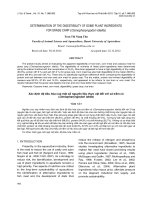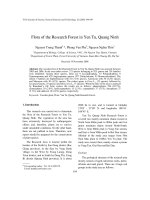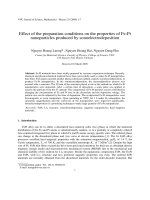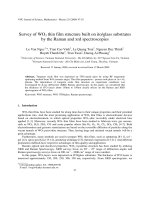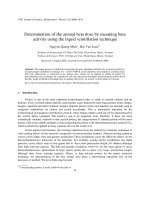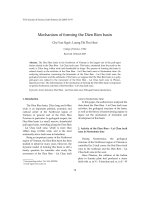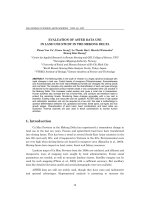Tài liệu BÁO CÁO " DETERMINATION OF THE DIGESTIBILITY OF SOME PLANT INGREDIENTS FOR GRASS CARP (Ctenopharyngodon idella) " pdf
Bạn đang xem bản rút gọn của tài liệu. Xem và tải ngay bản đầy đủ của tài liệu tại đây (138.02 KB, 7 trang )
J. Sci. & Devel., Vol. 10, No. 7: 986-992
Tạp chí Khoa học và Phát triển 2012. Tập 10, số 7: 986-992
www.hua.edu.vn
986
DETERMINATION OF THE DIGESTIBILITY OF SOME PLANT INGREDIENTS
FOR GRASS CARP (Ctenopharyngodon idella)
Tran Thi Nang Thu
Faculty of Animal Science and Aquaculture, Hanoi University of Agriculture
Email:
Received date: 30.10.2012 Accepted date: 22.12.2012
ABSTRACT
The present study aimed at evaluating the apparent digestibility of rice bran, corn meal and cassava meal for
grass carp (Ctenopharyngodon idella). The digestibility of nutrients of these plant-ingredients were determined
using the indirect method with the incorporation of Cr
2
O
3
. Rice bran appeared to have a high digestibility of dry matter
(80.3%), protein (87.9 %) and ash (97.4 %) for grass carp. Corn meal has also high digestibility of dry matter (88.9%),
protein (84.9%) and ash (92.7%). There was no statistically significant difference when comparing the digestibility of
protein and ash between rice bran and corn meal for grass carp. The dry matter, protein and minearl digestibility of
cassava was 80.3%, 87.9% and 14.3%, respectively, and appeared to be inferior to rice bran or corn meal. Our
results indicated that the grass carp digests rice bran and corn meal better than cassava meal.
Keywords: Cassava meal, corn meal, digestibility, grass carp, rice bran.
Xác định độ tiêu hóa của một số nguyên liệu thực vật đối với cá trắm cỏ
(Ctenopharyngodon idella)
TÓM TẮT
Nghiên cứu này nhằm mục đích xác định độ tiêu hóa của cá trắm cỏ (Ctenopharyngodon idella) đối với 3 loại
nguyên liệu là cám gạo, bột ngô và bột sắn. Việc xác định độ tiêu hóa của các dưỡng chất trong các nguyên liệu có
nguồn gốc thực vật được thực hiện theo phương pháp gián tiếp có sử dụng chất đánh dấu Cr
2
O
3.
Cám gạo cho kết
quả cao về độ tiêu hóa vật chất khô (80,3%), protein (87,9%) và chất khoáng (97,4%). Tương tự bột ngô cũng cho
kết quả khá cao về độ tiêu hóa vật chất khô (88,9%), protein (84.9%) và chất khoáng (92,7%). Không có sự khác biệt
có ý nghĩa thống kê khi so sánh độ tiêu hóa các dưỡng chất của cám gạo và bột ngô đối với cá trắm cỏ. Độ tiêu hóa
chất khô, protein và chất khoáng của bột sắn lần lượt là 80,3%, 87,9% và 14,3% và thấp hơn so với của cám gạo và
bột ngô. Kết quả bước đầu này cho thấy cá trắm cỏ tiêu hóa cám gạo và bột ngô tốt hơn bột sắn.
Từ khóa: Cám gạo, bột ngô, bột sắn, độ tiêu hóa, trắm cỏ.
1. INTRODUCTION
Presently, in the aquaculture industry, there
is the need to reduce the use of costly and scare
fish meal and fish oil (Sargent and Tacon, 1999;
Naylor et al., 2000; FAO, 2007). As a strategy to
reduce risk, the identification, development and
use of plant ingredients in aquafeeds remains a
high priority. Two aspects of nutrition are critical
to the long-term sustainability of aquaculture:
the identification of alternative ingredients to
fish meal and the development of diets that
reduce the release of nitrogen and phosphorus
into the environment (Donaldson, 1997). Several
studies investigating alternative ingredients to
replace fish meal have shown promising results
using plant ingredients (Gomes et al., 1995;
McGoogan and Gatlin, 1997; Mukhopadhyay and
Ray, 1999; Forster, 2002; Lee et al., 2002;
Pereira and Oliva-Teles, 2003; Chou et al., 2004;
Glencross et al., 2004). Alternative plant
ingredients help reduce price, alleviate pressure
on the stagnant industrial fish supply, and
promote sustainability.
Tran Thi Nang Thu
987
Grass carp is one of the most popular fresh
water fish in Northern Vietnam. The grass carp
is a member of the Cyprinid family
(Cyprinidae). This species was identified as a
herbivorous fish. Some aquatic weeds, larvae,
zooplankton are nutrient sources of grass carp
in nature. Under culture conditions, grass carp
can well accept artificial feed such as the by-
products from grain processing and vegetable
oil extraction meals, and pelleted feeds, in
addition to aquatic weeds and terrestrial
grasses (Dongmeza, 2009).
The digestibility of ingredients is one of the
most important data to formulate least-cost feed
formulation in aquaculture feed. Digestibility is
determined by comparing the quantity of
nutrient consumed with that present in the feces
at the end of the digestive process (Sullivan and
Reigh, 1995). Up to now, only few feed
ingredients currently used for grass carp in
Vietnam have been assessed for their digest
value. Thus, the main objective of this study is to
determine the digestibility of some plant
ingredients for grass carp. This study was
conducted in laboratory conditions and the
information gained is a good base for scientists
and extension workers to develop feed strategies
based on plant ingredients for grass carp.
2. MATERIALS AND METHODS
Rice bran, corn meal and cassava meal are
three plant-ingredients originated from Son La
Province, Viet nam. Each ingredient was milled
to produce the powder with a maximum particle
size of 500 µm. They were finely ground in order
to ensure the homogeneity in the finished diet
(Burel et al., 2000; Glencross et al., 2004a). In
addition, particle size has been considered as an
important factor affecting the ingredient
evaluation process (Kaushik, 2001; Nir and
Ptichi, 2001; Glencross et al., 2007).
2.1. Method in digestibility study
The apparent digestibility coefficients (ADC)
of dry matter, protein, ash and lipids of rice bran,
corn meal and cassava meal were calculated
indirectly using chromic oxide as an inert marker
by the method of substitution (Sugiura et al.,
1998; Bureau et al., 1999). A reference diet was
prepared containing 1 % chromic oxide. Three
test diets were made by mixing 70 % of the
reference diet mixture and 30 % of rice bran or
corn meal or cassava meal to be tested
(correspond with rice bran diet, corn diet and
cassava diet, respectively). The diets were
pelleted using a pellet mill (5 mm in diameter)
and stored at 4°C. Table 1 shows the ingredients
used in the reference and three test diets.
The digestibility experiment was carried
out with three replicates per treatment in a
thermoregulated water system with grass carp.
Each group of 10 grass carp (about 250 g) was
stocked into a 500-l cylindroconical tank.
Water temperature, water quality and light
regime were the same in all experimental tanks.
Table 1. Ingredient composition of the experimental diets used in the digestibility
measurement of rice bran, corn meal and cassava meal
Ingredients Reference diet (%) Rice bran diet (%) Corn diet (%) Cassava diet (%)
Wheat meal 9.7 6.8 6.8 6.8
Fish meal 52.0 36.2 36.2 36.2
Fish oil 3.3 2.3 2.3 2.3
Vitamin mixture 2.0 1.4 1.4 1.4
Mineral mixture 2.0 1.4 1.4 1.4
Soybean meal 30.0 20.9 20.9 20.9
Rice bran 30.0
Corn meal 30.0
Cassava meal 30.0
Cr
2
O
3
1.0 1.0 1.0 1.0
Total 100.0 100.0 100.0 100.0
Determination of the digestibility of some plant ingredients for grass carp (Ctenopharyngodon idella)
988
The fish were fed by hand to visual satiety
once a day. After 7 days of acclimatization with
the reference and test diets, the feces collection
was started. The feces were collected for 10 days
from each tank. For each diet, fecal samples
were collected daily and frozen. At the end of
the experiment, feces were dried. All diets and
feces were analyzed for dry matter, protein,
lipid, ash and chromic oxide contents.
The ADC of the reference diet were
calculated according to the following formulae:
ADC of DM of diet (%) = 100 x [1 - (dietary
Cr
2
O
3
/fecal Cr
2
O
3
)]
ADC of nutrients of diet (%) = 100 x [1 -
(dietary Cr
2
O
3
/fecal Cr
2
O
3
) x (fecal nutrient
concentration/dietary nutrient)]
The ADC of dry matter, nutrients in the
tested ingredient were calculated according to
the following formulae:
ADC of DM of test ingredient (%) = (ADC of
DM of the test diet - 0.7 x ADC of DM of the
reference diet)/0.3
ADC of nutrient of test ingredient (%) =
[(nutrient in test diet x nutrient ADC of the test
diet) - (0.7 x nutrient concentration in reference
diet x nutrient ADC of the reference diet)]/(0.3 x
nutrient concentration in ingredient)
Values were expressed in % of dry matter.
2.2. Chemical analyses
Proximate analyses of dry matter, crude
protein, crude lipid and crude ash of the
samples were conducted using the following
standard procedures (AOAC, 1995): dry matter
by drying at 105°C for 24 h, ash by incineration
at 550°C for 12 h, crude protein (N x 6.25) by
the Kjeldhal method after acid digestion, crude
lipid by the Soxhlet method. The determination
of chromium III (trivalent) that involves
digestion of organic matter, solubilisation of
chromium and determination of chromium was
conducted by photometry (Czarnocki et al.,
1961; Fenton and Fenton, 1979).
2.3. Data analysis
Data was examined by one way ANOVA
using SAS version 8 (SAS Institute, Cary, NC,
USA) software. Levels of significance were
determined using the Duncan test, with critical
limits being set at P<0.05.
3. RESULTS AND DISCUSSION
3.1. Chemical composition of the plant-
ingredients and experimental diets
Three plant-ingredients used in this study
were originated from Son La. Their chemical
compositions were analyzed before the
determination of its digestibility for grass carp.
The chemical compositions of rice bran, corn
meal and cassava meal are shown in Table 2.
In general, the chemical composition of
ingredients has influence on the digestibility of
its nutrients. The chemical composition of rice
bran, corn meal and cassava meal in literature
was presented in Table 3.
The chemical compositions of three plant-
ingredients in this study were not much different
with those used in many other researches. Many
authors reported the values ranging between
87.4 - 91.7%; 11.2 - 13.7%; 12 -17.9%; 7.4 - 13.6,
respectively, for dry matter, protein, lipid and
ash of rice bran (Table 3). The chemical
composition of rice bran in our study was in this
range as shown in table 2. However, the ash of
corn meal and cassava meal in this study were
slightly higher than that reported in literature.
This high value of ash can influence the
digestibility of other nutrients of ingredients.
Four experimental diets were formulated as
present in table 1. After pelleting, the diets were
analyzed for chemical composition and the
results are shown in table 4.
Table 2. Chemical compositions of studied ingredients
Ingredients Dry matter (%) Protein (%) Lipid (%) Ash (%)
Rice bran 92.7 13.8 14.8 8.4
Corn meal 88.2 9.1 4.8 7.9
Cassava meal 90.4 2.4 0.7 2.2
Tran Thi Nang Thu
989
Table 3. The chemical composition of rice bran, corn meal and cassava meal in literature
Ingredients Dry matter (%) Protein (%) Lipid (%) Ash (%) References
Rice bran 87.8 13.1 13.3 8.0 Hien et al., 2010
Rice bran 91 12.8 13.7 11.6 NRC, 1993
Rice bran 87.4 11.2 12.8 9.3
National Institute of Animal
Husbandry, 2002
Rice bran 91.7 12.6 12 7.4 Hien et al., 2010
Rice bran 89 13.7 17.9 13.6
National Institute of Animal
Husbandry, 2002
Corn meal 88 8.5 3.6 1.3 NRC, 1993
Corn meal 87.7 10.2 4.8 1.6 Hertrampf và Piedad, 2000
Casava meal 87 0.9 1.7 0.7 NRC, 1993
Casava meal 81.5 0.9 0.6 0.7
National Institute of Animal
Husbandry, 2002
Table 4. Chemical composition of the experimental diets used in the digestibility study
Diets Dry matter (%) Protein (%) Lipid (%) Ash (%)
Reference 97.65 30.58 10.7 21.86
Rice bran diet 93.49 26.28 11.5 16.20
Corn diet 93.35 24.41 9.1 14.42
Cassava diet 95.06 26.83 8.9 18.50
3.1. The digestibility of dry matter
The digestibility of dry matter of three
plant- ingredients for grass carp is presented in
table 5
The dry matter digestibility of rice bran and
corn meal was more than 80% and there was no
significant difference between these two
ingredients (table 5). The dry matter
digestibility of cassava was significant lower
(P<0.05) than rice bran and corn meal but
remain high. Law (1986) reported the dry
matter digestibility of corn meal for grass carp
was 64.76%, which was lower than that
obtained in our study (88.96%). In the other
study, the dry matter digestibility of corm meal
for tilapia was 82.21% (Guimaraes et al., 2009),.
This digestibility value was high and
comparable with our result. The dry matter
digestibility of cassava for Mekong river catfish
was 83.2% (Hien et al., 2010) and very close to
dry matter digestibility for grass carp in this
work. Guimaraes et al. (2009) determined 55.6%
dry matter digestibility of rice bran for tilapia
and much more inferior than that determined in
this study for grass carp. We can explain this
difference by the difference of ingredient source
or by the difference of digest capacity between
grass carp and tilapia. If the last is true, we can
consider grass carp digest rice bran much better
than tilapia.
3.2. The digestibility of protein
Table 6 shows the digestibility of protein of
three plant-ingredients for grass carp.
Table 5. Digestibility of dry matter of three plant - ingredients for grass carp
Diets Rice bran Corn meal Cassava meal
Digestibility of dry matter (%)
80.33 0.29
a
88.96 0.15
b
81.89 12.23
b
a,b
Within a row, means lacking a common superscript setter differ (P<0.05). Data are means of three replicates with
standard error (SE).
Determination of the digestibility of some plant ingredients for grass carp (Ctenopharyngodon idella)
990
Table 6. The digestibility of protein of three plant - ingredients for grass carp
Ingredients Rice bran Corn meal Casava meal
Digestibility of protein (%)
87.94 0.17
b
84.89 0.12
b
77.15 10.22
a
a,b
Within a row, means lacking a common superscript setter differ (P<0.05). Data are means of three replicates
with standard error (SE).
Some authors reported that the apparent
protein digestibility coefficients of plant
ingredients such as rice bran, banana leaf,
bamboo leaf, maize leaf in grass carp varied
between 28.4% to 92.9% (Hertrampf and Piedad,
2000; Dongmeza et al., 2009). The protein
digestibility value for rice bran, corn meal and
cassava meal in the present study was found in
this range. The high protein digestibility
(87.94%) demonstrates that rice bran protein is
highly available for grass carp. This value is also
higher than that reported in American catfish
(71 %; Hepher, 1988 or 76%; Halver and Hardy,
2002) and in grouper (59.5%; Laining et al.,
2003). The protein digestibility of corn meal for
grass carp in this study is higer than that for
tilapia as reported by Law (1986) and higher
than that for American catfish (60%; Halver et
al., 2002). The cassava meal appears to have a
lower protein digestibility (77.15%) than rice
bran and corn meal. Hien et al. (2010) found the
digestibility of protein of cassava meal for
Mekong river catfish was very low with the value
of 35.8%, so two times less than the result of our
study for grass carp. This big difference of the
digestibility can be explained by the interspecific
variation and by a variation in the quality of
cassava meal sources between studies.
3.3. The digestibility of ash
The digestibility of ash (or crude ash) of
three plant-ingredients is reported in table 7.
The digestibility of ash of rice bran and
corn meal was higher in grass carp in
comparison to cassava meal. The anti-
nutritional factors present in cassava meal may
affect apparent digestibility of ash (NRC, 1993).
The anti-nutritional factors can interfere with
digestion by binding to digestive enzymes or by
binding directly to some mineral elements
(Francis et al., 2001), thus, reduce their
availability for fish.
3.4. The digestibility of lipid
The source of rice bran, corn meal and
cassava meal used in the present study showed
a lipid digestibility of 82.4%, 80.6% and 71.3%,
respectively (table 8). The lipid digestibility of
cassava was significantly lower than that of
corn meal (P<0.05). Lipid digestibility of rice
bran for grass carp was highest in comparison
with corn and cassava meal.
Table 7. The digestibility of ash of three plant-ingredients for grass carp
Ingredients Rice bran Corn meal Casava meal
Digestibility of ash (%)
97.4 0.78
a
92.66 0.58
b
14.33 95.58
a
a,b
Within a row, means lacking a common superscript setter differ (P<0.05). Data are means of three replicates
with standard error (SE).
Table 8. The digestibility of lipid of three plant-ingredients for grass carp
Ingredients Rice bran Corn meal Casava meal
Digestibility of lipid (%)
82.4 0.98
a
80.6 0.7
b
71.3 0.42
c
a,b,c
Within a row, means lacking a common superscript setter differ (P<0.05). Data are means of three replicates
with standard error (SE).
991
4. CONCLUSION
This study has showed that grass carp
digested more dry matter, protein, ash and lipid
from rice bran and corn meal than from cassava
meal. Rice bran appeared to have a high
digestibility of dry matter (80.3%), protein (87.9
%) and ash (97.4 %) for grass carp. Corn meal
have also high digestibility of dry matter
(88.9%), protein (84.9%) and ash (92.7%). The
dry matter, protein and ash digestibility of
cassava was 80.3%, 87.9% and 14.3%,
respectively. Additional research is needed to
determine the digestibility of energy in these
plant ingredients to facilitate least-cost diet
formulation for grass carp.
Acknowledgements
The authors gratefully acknowledge the
ELAN project of the Commission Universitaire
pour le Developpement of Belgium for funding
this research.
REFERENCES
Association of Official Analytical Chemists (1995).
Official Methods of analysis, 16
th
ed. Arlington,
VA: AOAC.
Bureau, D.P., A.M. Harris, C.Y. Cho, (1999). Apparent
digestibility of rendered animal protein ingredients
for rainbow trout (Oncorhynchus mykiss).
Aquaculture, 180, 345-358.
Burel, C., T. Boujard, F. Tulli, S.J. Kaushik, (2000).
Digestibility of extruded peas, extruded lupin, and
rapeseed meal in rainbow trout (Oncorhynchus
mykiss) and turbot (Psetta maxima). Aquaculture
188, 285-298.
Chou, R.L., B.Y. Her, M.S. Su, G. Hwang, Y.H. Wu,
H.Y. Chen (2004). Substituting fish meal with
soybean meal in diets of juvenile cobia
(Rachycentron canadum). Aquaculture 229, 325-333.
Czarnocki, J., I.R. Sibbald, E.V. Evans (1961). The
determination of chromic oxide in samples of feed
and excreta by acid digestion and
spectrophotometry. Can. J. Anim. Sci. 41, 167-179.
Donaldson, E.M. (1997). The Role of Biotechnology in
Sustainable Aquaculture. In: Sustainable
Aquaculture (ed. by J.E. Bardach), p. 101-126.
John Wiley and Sons, New York.
Dongmeza, E. (2009). Studies on the nutritional quality
of plant materials used as fish feed in Northern
Vietnam. PhD thesis, Department of Aquaculture
Systems and Animal Nutrition, University of
Hohenheim,
Fenton, T.W., M.Fenton (1979). An improved
procedure for the determination of chromic oxide
in feed and faeces. Can. J. Anim. Sci. 59, 631-634.
FAO (2007). The state of world fisheries and
Aquaculture 2006. (Food and Agricultural
Organisation, Rome, 2007).
Forster, I. (2002). Use of soybean meal in the diets of
non-salmonid marine fish. United Soybean Board.
American Soybean Association. Available in
Francis, G., H.P.S. Makkar, K.Becker (2001).
Antinutritional factors present in plant-derived
alternate fish feed ingredients and their effects in
fish. Aquaculture 199, 197-227.
Glencross, B., D. Evans, W. Hawkins, B. Brian Jones
(2004). Evaluation of dietary inclusion of yellow
lupin (Lupinus luteus) kernel meal on the growth,
feed utilisation and tissue histology of rainbow
trout (Oncorhynchus mykiss). Aquaculture 235,
411-422.
Glencross, B.D., M. Booth, G.L.Allan (2007). A feed is
only as good as its ingredients: a review of
ingredient evaluation strategies for aquaculture
feeds. Aqua. Nutr. 13, 17-34.
Gomes, E.F., P. Rema, S.J. Kaushik (1995).
Replacement of fish meal by plant proteins in the
diet of rainbow trout (Oncorhynchus mykiss):
digestibility and growth performance. Aquaculture
130, 177-186.
Guimaraes, G., E.P. Luiz, M.Margarida, L.T. Barros
(2009). “Nutrient Digestibility of Cereal Gain
products and By-products in Extruded diets for
Nile Tilapia”. Journal of the World Aquaculture
Society.
Halver, J.E. and R. W.Hardy (2002). Fish nutrition.
The Third Edition. Academic Press, USA.
Hepher, B. (1988). Nutrition of pond fish. Cambridge
University Press. 141 pp.
Hien Tran Thi Thanh, N.T Phuong, T.C Le.Tu and B.
Glencross. (2010). Assessment of method for the
determination of digestibility of feed ingredients
for tra catfish (Pangasinodon hypothalamus).
Aquaculture Nutrition 16, pages 351-358.
Hertrampf, J.W. and F. Piedad Pascual (2000). Hand
book on Ingredients for Aquaculture Feeds.
Kluwer Academic Publishers, Dordrencht, The
Netherlands.
Kaushik, S.J. (2001). Feed technologies and nutrient
availability in aquatic feeds. In: Advances in
Nutritional Technology. Van der Poel, A.F.B.,
Vahl, J.L. and Kwakkel, R.P. eds, pp. 187-196.
Law, A.T. (1986). Digestibility of low-cost ingredients
in pelleted feed by grass carp (Ctenopharyngodon
idellus). Aquaculture 51, pages 97-103.
992
Laining, A., Rachmansyah, Taufik and K. Williams
(2003). Apparent digestibility of selected feed
ingredients for humpback grouper, Cromileptes
altivelis. Aquaculture Volume 218: 1- 4, pp 529 -538.
Lee, K.J., K. Dabrowski, J.H. Blom, S.C. Bai,
P.C.Stromberg, (2002). A mixture of cottonseed
meal, soybean meal and animal byproduct mixture
as a fish meal substitute: growth and tissue
gossypol enantiomers in juvenile rainbow trout
(Oncorhynchus mykiss). J. Anim. Physiol. Nutr.
86, 201-213.
McGoogan, B.B., D.M. Gatlin III (1997). Effects of
replacing fish meal with soybean meal in diets for
red drum (Sciaenops ocellatus) and potential for
palatability enhancement. World Aquac. Soc. 28,
374-385.
Mukhopadhyay N., A.K. Ray (1999). Effect of
fermentation on the nutritive value of sesame seed
meal in the diets for rohu (Labeo rohita, Hamilton)
fingerlings. Aquac. Nutr. 5, 229-236.
National Institute of Animal Husbandry (2002). Table
of chemical composition and nutritive values of
ingredients feed for animal. Hanoi agriculture
publish house.
National Research Council (NRC) (1993). Nutrient
requirements of fish. National Academic Press,
Washington D.C., USA, 115pp.
Naylor, R.L., R.J. Goldburg, J.H.Primavera, N.
Kautsky, M.C.M. Beveridge, J.Clay, C.Folke,
J.Lubchenco, H.Mooney, M. Troel (2000). Effect
of aquaculture on world fish supplies. Nature 405,
1017-1024
Nir, I., I. Ptichi (2001). Feed particle size and hardness:
influence on performance, nutritional, behavioral
and metabolic aspects. In: Advances in Nutritional
Technology. Van der Poel, A.F.B., Vahl, J.L.,
Kwakkel, R.P. eds, pp. 157-186.
Pereira, T.G., A. Oliva-Teles (2003). Evaluation of
corn gluten meal as a protein source in diets for
gilthead sea bream (Sparus aurata L.) juveniles.
Aquacult. Res. 34, 1111-1117.
Sargent, J.R., A.G.J. Tacon (1999). Development of
farmed fish: a nutritionally necessary alternative to
meat. Proc. Nutr. Soc. 58, 377-383.
Sugiura, S.H., F.M. Dong, C.K. Rathbone, R.W. Hardy
(1998). Apparent protein digestibility and mineral
availabilities in various feed ingredients for
salmonid feeds. Aquaculture 159, 177-202.
Sullivan, A.J., R.C. Reigh (1995). Apparent digestibility
of selected feedstuffs in diets for hybrid striped bass
(morone saxatilis female X morone chrysops male).
Aquaculture 138, 313-322
